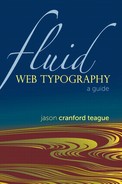0%
52Chapters
0-1Hours read
0kTotal Words
Book Description
The type that designers use can say as much to their audience as the actual words on the page. But until now, Web designers have had an extremely limited palette of typefaces from which to choose -- essentially, Arial (yawn), Times (yawn), and Georgia (yawwwwwn). Design is about overcoming the limitations of a medium, and Web design is no different. In this book, Jason shows Web designers how to apply the principles of fluid typography, Web-safe fonts, downloaded fonts, and type on images to create robust scalable designs without resorting to type in images or Adobe Flash.
